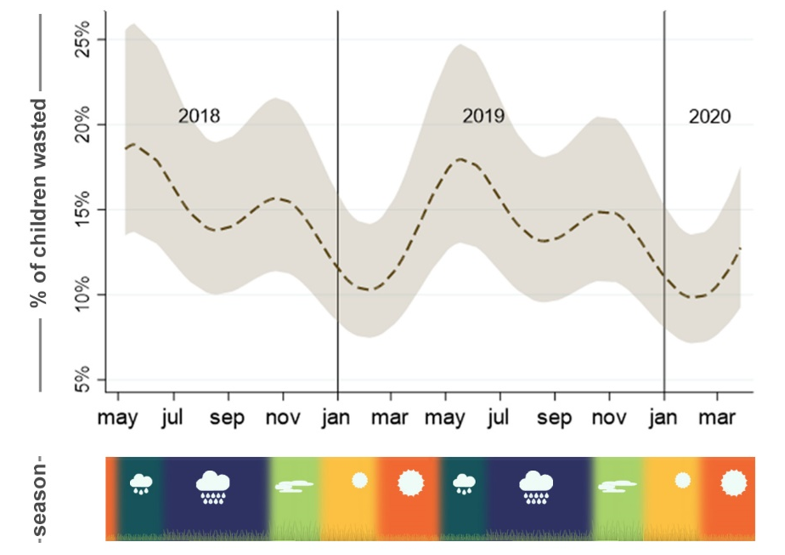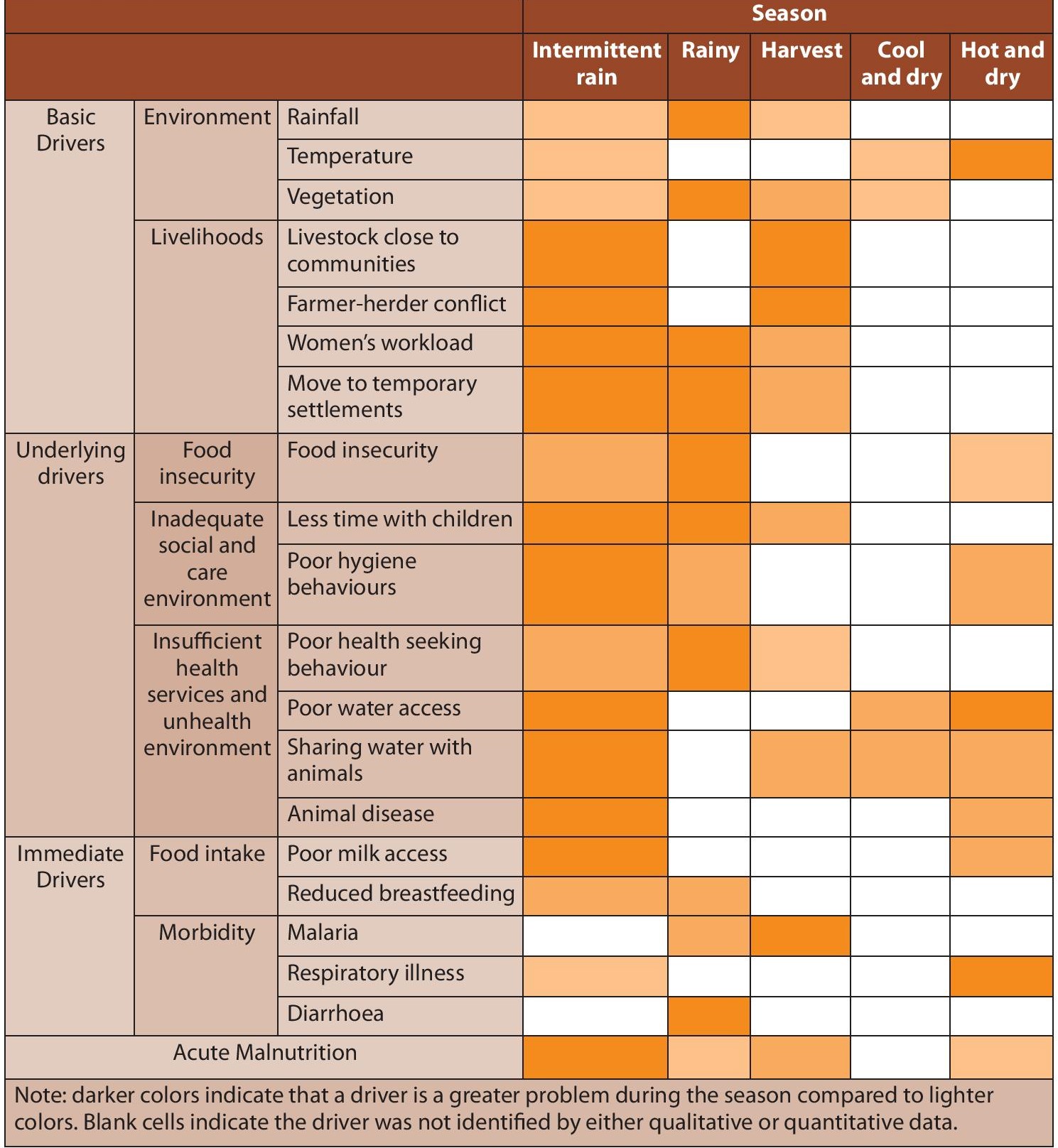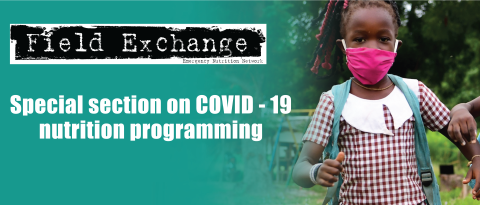Seasonality of acute malnutrition and its drivers: a case study from eastern Chad
Summary of research 1
By Anastasia Marshak, Gwenaëlle Luc, Anne Radday and Helen Young
Anastasia Marshak is a Senior Researcher at the Feinstein International Center at Tufts University. She has over 10 years of experience working in humanitarian contexts with a focus on study design and methods, evaluating impact on nutrition and food security outcomes.
Gwenaëlle Luc is a social anthropologist who currently works for the global Food Security Cluster, led by the Food and Agriculture Organization and World Food Programme, steering efforts to address food crisis amongst humanitarian, development and peace actors.
Anne Radday is the focal point for research communications and knowledge management at the Feinstein International Center, Tufts University. She has more than 15 years of experience in marketing and communications, knowledge management, knowledge product development, organisational strategy and external relations.
Helen Young is a Professor at the Friedman School of Nutrition Science and Policy, Tufts University, where she directs Feinstein’s Research Program on Nutrition, Livelihoods and Conflict. Over the past 35 years her research has contributed to practical guidelines, policy changes, minimum standards, institutional learning and capacity development.
The authors would like to express thanks for the support of their partner, Concern Worldwide, especially Chris Pain, Franck Flachenberg, Amanda Yourchuck, Kate Golden, Isaac Gahungu, Laurent DeRuyt, Baba Lassou, Abdoulaye Danni and Bella Hodgkinson. In addition, the authors thank the quantitative and qualitative data collection team and the coliform analyst. This research would not have been possible without the respondents who, month in and month out, continued to share valuable information about their lives and communities and to donate their precious time to the research. Finally, we would like to thank Irish Aid for their generous funding.
Location: Sila Province, Chad
What we know: The existing evidence base on acute malnutrition seasonality is limited and fraught with methodological constraints resulting in the predominance of the assumption that acute malnutrition peaks during the ‘lean season’ or ‘hunger gap’.
What this article adds: This article summarises findings from a 23-month study following approximately 200 children age 6-59 months across 89 households in eastern Chad. Results indicate that there are two peaks of acute malnutrition. The primary and larger peak occurs at the start of the rains corresponding to the first weeks of intermittent rain. Acute malnutrition prevalence declines during the rainy season as food insecurity increases and peaks again, but only slightly, immediately before the harvest. The results highlight the need to reconsider programme focus, design, timing and evaluation in light of the possible multiple seasonal peaks of acute malnutrition, likely corresponding to a set of different drivers.
Background
Previous evidence has highlighted the role of seasonality in acute malnutrition where changes in environmental conditions trigger the underlying and immediate drivers of acute malnutrition and lead to increases in prevalence. In contexts with one main rainy season and a population that partially depends on farming for their livelihood, as is in Chad and much of the Sahel, there is a predominant narrative that acute malnutrition peaks once during the rainy season (the so-called ‘hunger gap’ or ‘lean season’) as a result of a combination of increasing food insecurity and disease burden, particularly malaria (Chambers et al, 1981; Devereux, 2012). This prevailing assumption is so strong in literature that seasonality is more often assumed than documented. However, the evidence base is relatively limited, only testing for the possibility of one peak or frequently aggregating and/or comparing prevalence data across a small number of seasons (Marshak et al, 2020). Recently, there have been renewed efforts to better understand the seasonality of nutrition outcomes (FAO & Tufts, 2019; Young, 2020). This article summarises a research study that aimed to describe seasonal patterns of and relationships between acute malnutrition and some of the potential drivers including water contamination and livestock management among communities in eastern Chad in order to inform and influence programmes and policies that address persistent acute malnutrition in the region.
Methodology
Concern Worldwide and Tufts University collaborated to conduct a two-year mixed-methods study in the Sila Region of eastern Chad based on a panel survey and qualitative interviews. Eight villages were purposely selected for the study based on Concern Worldwide’s ability to access these throughout the year. Eighty-nine households with at least one child under 59 months of age were then randomly selected. The study followed the same households and their children monthly from May 2018 through to March 2020. As children aged out of the study (i.e., became over 59 months of age) they were removed from the study, while children who aged into the age criteria (i.e., turned six months of age) were added. By March 2020, the study included 212 individual children. In addition, data was collected on coliform contamination (a measure of the amount of fecal matter in the water) across the water chain for the 89 households. We used mixed-effects harmonic regression to analyse the seasonality of child wasting (weight-for-height z-score <-2 standard deviations). Qualitative data collection including focus groups, key informant interviews and semi-structured individual interviews was carried out in August 2018 and May/June 2019 – times that correspond to the two hypothesised peaks of wasting.
Key findings
Seasonal peaks in wasting
We identified two peaks of acute malnutrition within a calendar year (Figure 1). The highest peak was in May, corresponding to the locally identified season of rushash, characterised by intermittent rainfall that lasts for approximately three weeks prior to the start of the rainy season. We then saw a decline in the prevalence of acute malnutrition during the rainy season itself followed by a smaller secondary peak in October, immediately prior to the harvest. These findings highlight that the previously commonly held assumption around seasonality is not always accurate and, while the secondary acute malnutrition peak corresponds to the timing of high food insecurity and malaria risk, both the presence of the first peak and the improvement in wasting that occurs during the rainy season indicates that food security and malaria cannot be the main drivers of the first peak during rushash. This seasonal pattern may be generalisable to the greater Sahel region more broadly as the presence of two peaks in wasting is consistent with findings from a recent analysis of half a million child observations over 15 years of SMART surveys across the Sahel (Venkat, 2021).
Figure 1: Predicted prevalence and confidence intervals for wasting by month and season in Sila Province, Chad

When exploring the basic, immediate and underlying drivers of acute malnutrition, clear seasonal patterns emerge. As Table 1 depicts, all the drivers identified through both the qualitative and quantitative data collection appear to be seasonal. Findings suggest that the main peak of acute malnutrition prior to the start of the rains corresponds to limited water access, an increased concentration of animals at water sources and hence increased sharing of water resources by animals and humans resulting in the consumption of contaminated water and decreased absorption of nutrients in children. The secondary and smaller wasting peak, immediately before the harvest, corresponds to the period of lowest food security and a greater burden of malaria. The encouraging news is that, during the cool dry season, wasting prevalence drops significantly.
Table 1: Basic, immediate and underlying drivers of acute malnutrition, by season in Sila Province, Chad

Programme implications and broader recommendations
The results of the study reveal a far more complex and nuanced pattern of the seasonality of child acute malnutrition than previously assumed or documented indicating that all monitored drivers are seasonal and thus need to be addressed seasonally. These findings have direct implications for research, policy and programming as follows.
Invest in formative research on seasonality
When programmes aim to have a longer-term sustainable impact, formative research to identify seasonal patterns of acute malnutrition and the associated drivers is essential. Without a clear, evidence-driven understanding of seasonality, programmes and policies could be targeting the wrong driver, or the right driver at the wrong time, resulting in significantly lower impact on acute malnutrition as well as wasting resources. A first step in this process is to document the local seasons and engage the community to identify drivers during each season. Similarly, quantitative data collection would require multiple within-year observations to correspond to the local seasons to identify how nutrition outcomes and their drivers might vary.
Promote a multi-temporal approach
There is a general agreement that we need to take a multi-sector approach to successfully prevent acute malnutrition. However, we must also take a multi-temporal approach – i.e., addressing the different drivers of acute malnutrition at relevant times and seasons. This is already a focus within the agricultural and food security sectors which have long since timed appropriate supplies and messaging according to the agricultural cycle. However, a seasonal mindset is far less common in other sectors, with a few exceptions, including the CMAM Surge Approach (Concern Worldwide, 2021). Grounding programme timing in a seasonal perspective would foster greater efficiency across programmes as it would allow organisations to focus on specific drivers at specific times of the year, tailoring programmes and messaging accordingly.
Monitor and evaluate key outcomes by season
The seasonality of acute malnutrition and its drivers also has implications for data collection, be it the annual timing of SMART surveys, routine programme monitoring or general evaluations of programme impact on child nutrition. Mistiming data collection could result in either an under or over-estimation of nutrition outcomes as well as the programme impact on those outcomes. For example, in Chad, an evaluation of food security programmes on nutrition outcomes should occur at the end of the rainy season when that driver is likely to be most critical, while an evaluation of a programme on hygiene and sanitation is likely to show the greatest impact on nutrition at the end of the dry season. Furthermore, just as with seasonal programme implementation, focusing on monitoring and evaluations activities around the timing of when different drivers are at their seasonal worst could further increase efficiency and simplify planning and data collection.
Conclusion
Future programming and research must better understand and incorporate the seasonal nature of both acute malnutrition and all its drivers in order to be effective. This process starts with more formative mixed-methods longitudinal research, the design of and investment in evidence-driven multi-sector and multi-temporal programming and monitoring and evaluation that reflects the complex and nuanced seasonality of acute malnutrition and its drivers.
For more information please contact Anastasia Marshak at Anastasia.marshak@tufts.edu
1 Marshak, A., Luc, G., Radday, A., and H. Young (2021) “Seasonality of Acute Malnutrition and its Drivers in Sila, Province Chad: a mixed methods analysis”. Feinstein International Center, February 2021 https://fic.tufts.edu/research-item/seasonality-of-malnutrition-in-eastern-chad/
References
Chambers, R, Longhurst, R and Pacey, A (1981) Seasonal dimensions of poverty. 1981, London: Frances Pinter.
Concern Worldwide (2021) The CMAM Surge Approach https://www.concern.net/insights/cmam-surge-approach
Devereux, S, Sabates-Wheeler, R and Longhurst, R (2012) Seasonality, rural livelihoods and development. 2012, New York: Earthscan.
Marshak, A et al (2020) Sensitivity of Nutrition Indicators to Measure the Impact of a Multi-Sectoral Intervention: Cross-Sectional, Household, and Individual Level Analysis. Int J Environ Res Public Health, 2020. 17(9).
Marshak, A, Luc, G, Radday, A and Young, H (2021) “Seasonality of Acute Malnutrition and its Drivers in Sila, Province Chad: a mixed methods analysis”. Feinstein International Center, February 2021 https://fic.tufts.edu/research-item/seasonality-of-malnutrition-in-eastern-chad/
FAO and Tufts (2019) Twin peaks: the seasonality of acute malnutrition, conflict, and environmental factors in Chad, South Sudan, and the Sudan. 2019, Food and Agricultural Organization: Rome and Boston.
Young, H (2020) Nutrition in Africa's drylands: A conceptual framework for addressing acute malnutrition. 2020, Feinstein International Center, Tufts University.
Venkat, A et al (2021) Seasonality of acute malnutrition in African drylands: a review of 15 years of nutrition surveys. in progress, 2021.


